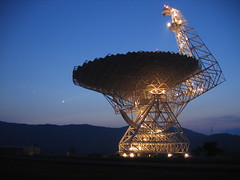
The Robert C. Byrd telescope at Green Bank in West Virginia, called by almost everyone the GBT, is a radio telescope. With an elliptical dish 100 meters by 110 meters, it's the biggest fully-steerable telescope in the world - much to the chagrin of the people in the tourist center at Effelsberg, whose telescope is 100 meters but circular.
As a single-dish radio telescope, the GBT really only puts one pixel on the sky at a time, so making an image is a slow and laborious process. People do it, but where the GBT really shines is for looking at other aspects than spatial resolution. It really shines when looking at spectral lines - which lets you map out moving gas along the line of sight - and for pulsar observations.
The GBT is also used in conjunction with Arecibo for radar experiments: Arecibo has a big radar transmitter that can be used to bounce radio waves off objects in the Solar System. But since transmitting and receiving at the same station can be a problem, often projects will use the GBT as a receiver for these radar transmissions.
As a machine, the GBT is quite astonsihing: seven million kilograms of moving mass. The people at the visitor center like to say that it's the largest moving object on land, which is not quite true, but the counterexamples - the Saturn V aboard its transporter, and a colossal dragline excavator so big it walks instead of rolls - put the scale in context.
One of the most valuable features of the GBT is its location in the National Radio Quiet Zone. Not only is there no cell phone or pager service, the NRAO has a converted ice cream truck they drive around searching for sources of radio noise (for example in one story they tracked down one noise source to a local family's malfunctioning electric blanket; the family didn't want to part with it so the observatory bought them a new one). This absence of local interference makes a tremendous difference when looking for new pulsars (among many other tasks), and sure enough surveys at the GBT have been very productive of new pulsars.









No comments:
Post a Comment